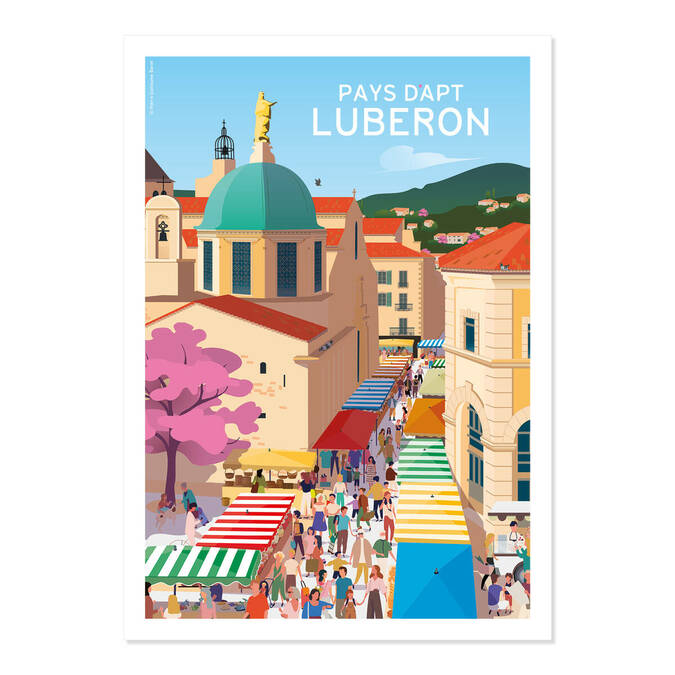
Situated in the heart of the Luberon region, of which it is the capital, Apt is a typically Provencal town.
Renowned for the quality of its local produce, it is known as the world capital of candied fruit, and is classified as one of the "Sites remarquables du goût"!
Its market is a living testimony to this, stretching across half of the town center, from Place de la Bouquerie to Place de la Mairie, and crossing Rue des Marchands to Cours Lauze de Perret. Exhibitors can also be found in the narrow streets and squares of Carnot, Septier, Jean-Jaurès and Saint-Pierre.
A little History...
Apta Julia was founded by the Romans around 45 BC on the Via Domitia, certainly as a tribute to Julius Caesar.
Tradition has it that Julius Caesar stopped off in Apt on his way back from a campaign.
During the "Gaule Narbonnaise" period, Apt was one of 24 cities in the region. A very prosperous city, Apta Julia boasted a forum, a triumphal arch, a capitol, a temple, thermal baths and a theater as important as that of Orange. At the time, its population was around 10,000, only slightly less than today.
Throughout its history, Apt was plundered by the Saracens... then ravaged by the plague in 1348 and 1720. Apt's population was also torn between the Vaudois, Catholics and Protestants.
In 1790, Apt was promoted to the rank of sub-prefecture.
A rich religious heritage
Apt is also attractive for its small, shady streets, its many squares with beautiful fountains, its handsome townhouses and its cathedral, a listed historic monument.
The early Christian cathedral, probably destroyed by invasion, was rebuilt in the 11th century. Major alterations were carried out in the 14th and 18th centuries, profoundly modifying the central nave.
Sainte-Anne Cathedral is adorned with a majestic Sainte-Anne covered in gold leaf.
The lower crypt is the remains of a 1st-century Roman building used for religious purposes from the Carolingian era onwards. It comprises a corridor leading to a vault where, according to legend, Sainte-Anne's veil was found.
The 11th-century upper crypt consists of a small nave (approx. 8 m long) ending in an apse. On the sides, 7 niches contain Christian sarcophagi. The altar consists of a pre-Romanesque lapidary table set on a Roman funerary cippus, 3 sides of which bear inscriptions.
Sainte-Anne chapel was built in the mid-17th century, the work being largely financed by Anne of Austria in fulfillment of a vow - the belated birth of the future Louis XIV.
The Musée d'Apt and the Maison du Parc naturel
The Musée d'Apt features an exhibition tracing the history of economic activity in the Pays d'Apt Luberon, through its three major industries: earthenware, ochre and candied fruit, of which Apt is the world capital, and all three of which have made its reputation.
The museum is housed in part of the former Marliagues candied fruit factory.
In the heart of downtown Apt, the Maison du Parc Naturel is housed in a recently renovated 18th-century townhouse. Open to the public all year round, it features a permanent exhibition and a geology museum, enabling visitors to discover the characteristics of the Luberon that have made this territory such an exceptional area, designated a Regional Nature Park and recognized as a Biosphere Reserve and Global Geopark by Unesco.
Admission to the museum and exhibition is free.
he House of candied fruit
La Maison du fruit confit, the world capital of candied fruit, offers free access to a museographic and multimedia space of almost 100 m2 that transports you into the world of candied fruit in the heart of the Luberon, from Antiquity to the present day, and lets you discover the secrets of candied fruit from Provence as you wander through the spaces enhanced by exclusive films.
You can also awaken your senses with the olfactory tour available throughout the visit. Wooden scent diffusers contain the sweet fragrances of candied fruit. In the store area, a tasting table is available for you to discover the products.
For groups of 10 or more, the Maison du fruit confit offers a guided tour of the museum, with a special tasting session, for €15/person.
Further information: 04 90 76 31 66
Other sights to see...
The Porte de Saignon was one of Apt's six gates, giving access to the eastern part of the town. It replaced an earlier 14th-century gateway and opened onto the present-day rue Saint-Pierre, then known as rue des Briards.
The 14th-century Tour de l'Ho is one of the few remaining vestiges of the medieval city walls.
The Place de la Bouquerie is the beating heart of the Cité, with its fountain featuring a large basin for cattle to drink from. From this basin rises a column whose capital supports a statue called La Mourre, the work of local sculptor Auguste Mourre.
Place du Septier, lined with mansions including the Palais Consulaire Colin d'Albertas, built at the request of the Consul d'Albertas in the mid-17th century, a jewel of Provencal Baroque art.
Place de la Mairie. The sous-préfecture, a former episcopal palace with a classical facade and a superb double staircase.
The Moulin de Salignan, a former windmill, houses a small permanent geological exhibition on the division of time in geology and the Aptian floor. The latter was created by Alcide d'Orbigny in 1840 and can be visited free of charge during tours organized by the Maison du Parc in July and August.
Further information on 04 90 04 42 00
Pays d'Apt Luberon Tourist Office
Apt Office
788, Avenue Victor Hugo
84400 Apt
Tel.: 04 90 74 03 18
www.luberon-apt.fr
Apt Town Hall
Place Gabriel Péri
84400 Apt
T. : 04 90 74 00 34
www.apt.fr






